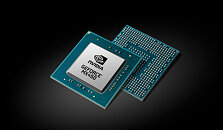- Joined
- Oct 9, 2007
- Messages
- 47,677 (7.43/day)
- Location
- Dublin, Ireland
| System Name | RBMK-1000 |
|---|---|
| Processor | AMD Ryzen 7 5700G |
| Motherboard | Gigabyte B550 AORUS Elite V2 |
| Cooling | DeepCool Gammax L240 V2 |
| Memory | 2x 16GB DDR4-3200 |
| Video Card(s) | Galax RTX 4070 Ti EX |
| Storage | Samsung 990 1TB |
| Display(s) | BenQ 1440p 60 Hz 27-inch |
| Case | Corsair Carbide 100R |
| Audio Device(s) | ASUS SupremeFX S1220A |
| Power Supply | Cooler Master MWE Gold 650W |
| Mouse | ASUS ROG Strix Impact |
| Keyboard | Gamdias Hermes E2 |
| Software | Windows 11 Pro |
NVIDIA released a mysterious new mobile GPU that has us scratching our heads over the silicon that could be driving it. The new GeForce MX450 is an entry-mainstream mobile GPU that apparently ships with a PCI-Express gen 4.0 bus interface, something only NVIDIA's "Ampere" GPUs feature. The product page for the MX450 doesn't list out any other specs, than its memory type support including new GDDR6 memory (supported only on NVIDIA architectures "Turing" or later). Interestingly, it also lists GDDR5 as one of its memory options. PCI-Express 4.0 is prominently listed as one of its specs.
Upon digging some more among device IDs, we've come across the ID of the GDDR5 variant, with the ASIC code "GP107-670-A1," and the silicon is based on the much older "Pascal" architecture, which lacks PCIe gen 4 support. The GDDR6 variant eludes us. This is the SKU which could be based on a newer architecture, given its support for GDDR6 and PCIe gen 4. NVIDIA's GeForce MX line of entry-mainstream mobile GPUs are built to performance/power targets, and wildly vary with the underlying tech. They've been historically a means for NVIDIA to clear inventory of older generation ASICs to notebook manufacturers, who get put the NVIDIA logo on their products, and advertise discrete graphics. Given this, the use of a newer (even unreleased) generation of GPUs comes as a surprise.


View at TechPowerUp Main Site
Upon digging some more among device IDs, we've come across the ID of the GDDR5 variant, with the ASIC code "GP107-670-A1," and the silicon is based on the much older "Pascal" architecture, which lacks PCIe gen 4 support. The GDDR6 variant eludes us. This is the SKU which could be based on a newer architecture, given its support for GDDR6 and PCIe gen 4. NVIDIA's GeForce MX line of entry-mainstream mobile GPUs are built to performance/power targets, and wildly vary with the underlying tech. They've been historically a means for NVIDIA to clear inventory of older generation ASICs to notebook manufacturers, who get put the NVIDIA logo on their products, and advertise discrete graphics. Given this, the use of a newer (even unreleased) generation of GPUs comes as a surprise.


View at TechPowerUp Main Site



